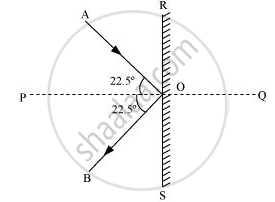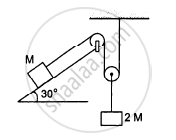Advertisements
Advertisements
Question
A batsman deflects a ball by an angle of 45° without changing its initial speed which is equal to 54 km/h. What is the impulse imparted to the ball? (Mass of the ball is 0.15 kg.)
Solution
The given situation can be represented as shown in the following figure.

Where,
AO = Incident path of the ball
OB = Path followed by the ball after deflection
∠AOB = Angle between the incident and deflected paths of the ball = 45°
∠AOP = ∠BOP = 22.5° = θ
Initial and final velocities of the ball = v
Initial velocity's horizontal component = vcos θ along RO
Initial velocity's vertical component = vsin θ along PO
Final velocity's horizontal component = vcos θ along OS
Final velocity's vertical component = vsin θ along OP
The horizontal velocity components remain unchanged. The vertical velocity components are directed oppositely.
∴Impulse imparted to the ball = Change in the linear momentum of the ball
`= mvcostheta - (- mvcos theta)`
`= 2mvcos theta`
Mass of the ball, m = 0.15 kg
Velocity of the ball, v = 54 km/h = 15 m/s
∴ Impulse = 2 × 0.15 × 15 cos 22.5° = 4.16 kg m/s
APPEARS IN
RELATED QUESTIONS
A free 238U nucleus kept in a train emits an alpha particle. When the train is stationary, a nucleus decays and a passenger measures that the separation between the alpha particle and the recoiling nucleus becomes x at time t after the decay. If the decay takes place while the train is moving at a uniform velocity v, the distance between the alpha particle and the recoiling nucleus at a time t after the decay, as measured by the passenger, is
A block of mass 0.2 kg is suspended from the ceiling by a light string. A second block of mass 0.3 kg is suspended from the first block by another string. Find the tensions in the two strings. Take g = 10 m/s2.
An empty plastic box of mass m is found to accelerate up at the rate of g/6 when placed deep inside water. How much sand should be put inside the box so that it may accelerate down at the rate of g/6?
Find the acceleration of the block of mass M in the situation shown in the following figure. All the surfaces are frictionless and the pulleys and the string are light.

Two bodies A and B of same mass are moving with velocities v and 2v, respectively. Compare their (i) inertia and (ii) momentum.
State the Newton's second law of motion. What information do you get from it?
State Newton's second law of motion. Under what condition does it take the form F = ma?
The linear momentum of a ball of mass 50 g is 0.5 kg m s-1. Find its velocity.
A pebble is thrown vertically upwards with a speed of 20 m s-1. How high will it be after 2 s? (Take g = 10 m s-2)
Use Newton's second law to explain the following:
While catching a fast moving ball, we always pull our hands backwards.
